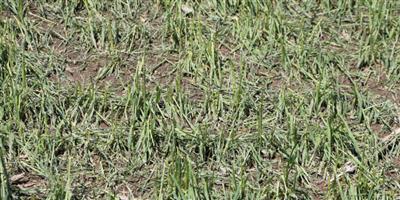Written collaboratively by David Karki, SDSU Extension Agronomy Field Specialist and Connie Strunk,
In spite of technological advancement in crop genetics and farm equipment, crop production largely depends on the weather and weather-related stress. Hail is one weather factor that can significantly impact crop growth and development. Central South Dakota, primarily a wheat growing region received hail and high winds during the fourth week of May and also during the following weekend. The majority of the winter wheat in this area was at heading and flowering stages. The spring wheat was at late tillering to early jointing stages.
Impact on Wheat Growth
Wheat in the early growth stages (such as the spring wheat in this case) will likely grow back and put on heads later in the season without much impact on the grain yield, whereas the impact to grain yield in winter wheat is more critical at this stage. The higher the hail damage on the stem, the more negative impact there will be on grain yield. A simulated hail damage study conducted at North Dakota State University reported severe yield loss when the hail damage occurred higher on the stem and just below the head. The same study also reported that the damage on heads at milk stage produced low test weight seeds.
How to Determine Potential Yield Loss
Proper assessment of hail damage can be done by counting damaged stems in one linear foot of wheat row at different parts of the affected wheat field and average the number of damaged stems or heads. Depending on the plant row spacing, the one row-foot will sum up to a different unit area, but it is simple if the number of damaged plants is counted on a one square foot basis first to estimate the total loss in an acre.
In a 7.5 inch row, one damaged plant per row-foot is equal to 1.6 plants per square foot as 7.5 inches is an 0.625th of a foot. One acre is about 43,560 sq. feet and the average wheat head contains about 22 kernels. Therefore one damaged plant per row-foot will result into a loss of 15,333,312 kernels per acre (i.e. 1.6 x 22 x 43560). If the seed weight of the planted variety is 16,000 seeds per pound, the total loss per acre will be 95 lbs. (i.e. 15333312/16000).
If the plant rows are wider, the total loss per acre will be less if one plant per row-foot is damaged. For example, a 10 inch row will account to a total loss of 79 lbs. per acre (i.e. 95 x 0.833).
Suggested Reading:
- Busch, R.H. 1965. Simulated Hail Damage in Spring Wheat.
- Klein, B. 2014. Assessing Hail Damage in Wheat. University of Nebraska Extension, Lincoln, NE.
Source: SDSU iGrow
Hail damaged wheat in Stanley County. Photo by Connie Strunk.


